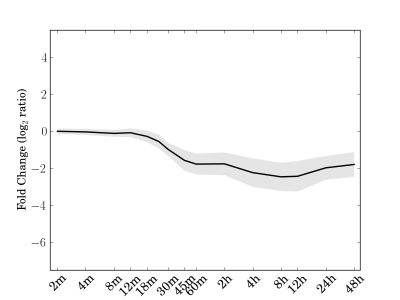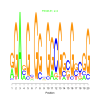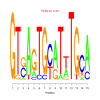Module 65 Residual: 0.14
| Title | Model version | Residual | Score |
|---|---|---|---|
| bicluster_0065 | v02 | 0.14 | -12.57 |
Displaying 1 - 20 of 20
| Cre01.g048150.t1.2 Staphylococcal nuclease homologue | Cre01.g049000.t1.2 Transcriptional coactivator/pterin dehydratase |
| Cre02.g073850.t1.2 photosystem II 11 kDa protein-related | Cre02.g142266.t1.1 cytochrome P450, family 97, subfamily A, polypeptide 3 |
| Cre03.g198950.t1.2 Mog1/PsbP/DUF1795-like photosystem II reaction center PsbP family protein | Cre03.g213537.t1.1 basic transcription factor 3 |
| Cre04.g216950.t1.2 3-ketoacyl-acyl carrier protein synthase III | Cre09.g387800.t1.2 ferritin 3 |
| Cre09.g389430.t1.1 phenylalanyl-tRNA synthetase, putative / phenylalanine--tRNA ligase, putative | Cre09.g398289.t1.1 Phospholipid/glycerol acyltransferase family protein |
| Cre12.g487100.t1.2 methionyl-tRNA synthetase / methionine--tRNA ligase / MetRS (cpMetRS) | Cre12.g500950.t1.2 CLP protease P4 |
| Cre12.g511150.t1.2 NAD-dependent glycerol-3-phosphate dehydrogenase family protein | Cre12.g532100.t1.2 |
| Cre12.g534700.t1.2 FKBP-like peptidyl-prolyl cis-trans isomerase family protein | Cre13.g580350.t1.2 |
| Cre14.g627850.t1.2 Dihydrodipicolinate reductase, bacterial/plant | Cre16.g654500.t1.1 eukaryotic translation initiation factor 2 |
| Cre16.g681900.t1.2 SECY homolog 1 | Cre16.g688800.t1.2 |
|
e.value: 2 Motif Bicluster: Width: 20 Number of Sites: 1 Consensus: gGAnGcGGnGGCGgcGgcgG |
motif_0065_2Submitted by Anonymous (not verified) on Wed, 05/20/2015 - 14:16e.value: 82 Motif Bicluster: Width: 15 Number of Sites: 1 Consensus: GTgAGTGcATtTGCA |
Displaying 1 - 1 of 1
| Interaction | Weight | |
|---|---|---|
Displaying 1 - 1 of 1
| GO Terms | Descriptions |
|---|---|
| Not available |




Comments